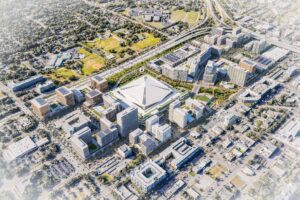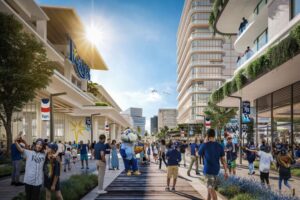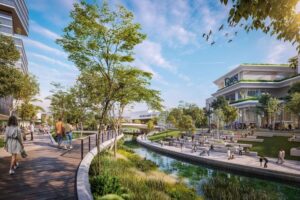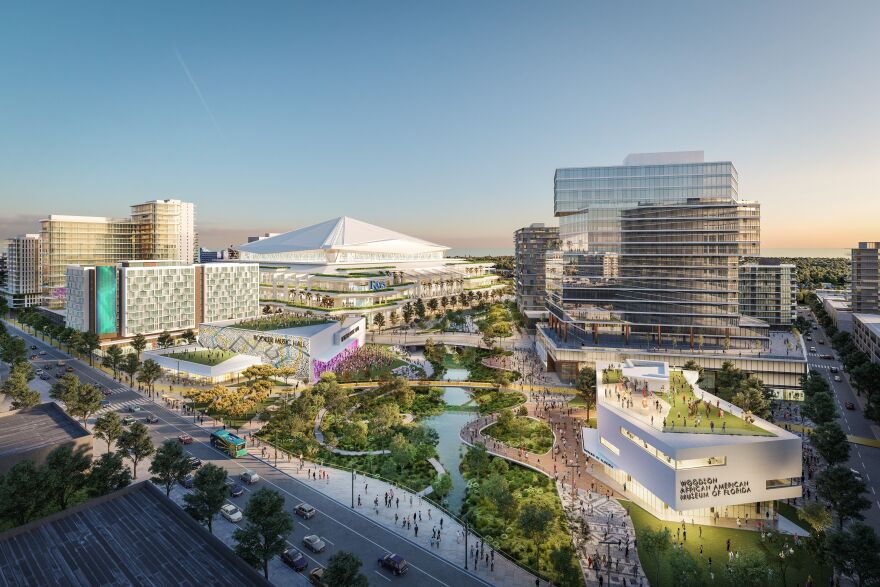Longtime REVITALIZATION readers know that we’ve been following the on-again, off-again efforts to redevelop the 86-acre Historic Gas Plant District (AKA: Tropicana Field) near downtown St. Petersburg, Florida for many years.
That’s partly because it’s an important project, and partly because I (Storm Cunningham) lived in St. Petersburg and nearby Clearwater for 15 years. and love the place.
Most recently, we covered the four responses to the new RFP issued by the city. Now, in the article below from WUSF (the public radio station of the University of South Florida in Tampa), we look at the winning proposal.
******************
 St. Petersburg Mayor Ken Welch chose the Hines-Rays team to reimagine Tropicana field and the Historic Gas Plant District. Here are the details of the proposal.
St. Petersburg Mayor Ken Welch chose the Hines-Rays team to reimagine Tropicana field and the Historic Gas Plant District. Here are the details of the proposal.
After Welch scrapped the Historic Gas Plant District plans preferred by former mayor Rick Kriseman, he requested a new wave of proposals be submitted.
Out of the four new development proposals that aimed to revamp Tropicana Field and surrounding community, Welch chose the Hines-Rays team to complete the project.
The project’s impact, though it may be slow in coming, will have rippling effects in the realms of affordable housing, cultural centers, and economic boosts.
Here are some key elements spelled out in the Hines-Rays proposal:
Culture
 The plan includes space allotted for cultural activities. The Development Proposal Evaluation says that the proposed Booker Music Hall will seat between 2,500 and 3,000 people.
The plan includes space allotted for cultural activities. The Development Proposal Evaluation says that the proposed Booker Music Hall will seat between 2,500 and 3,000 people.
The new Woodson African American Museum and Booker Music Hall will “act as pendants to one another, anchoring the north end of the Booker Creek Greenway along First Ave South, just steps from the main entrance of the Rays new ballpark.”
The Woodson African American Museum will be dedicated as “space to honor the history of the Gas Plant neighborhood and expanded access to public educational opportunities,” according to the proposal.
The new 30,000 square foot facility will be relocated from its current location in Jordan Park. It will be the first newly constructed landmark museum in the state dedicated to celebrating African American history, art, and culture.
The African American Cultural Heritage Loop will connect with the city’s park system and with the existing African American Heritage Trail.
The development will also include the “Gameday Street Experience.”
The streets surrounding the ballpark will be walkable and will center around food vendors and family-friendly entertainment.
Green Space
 Referred to as “activated outdoor space” in the project proposal, the development will include outdoor event space, emblematic paving, connective tree cover and a victory garden.
Referred to as “activated outdoor space” in the project proposal, the development will include outdoor event space, emblematic paving, connective tree cover and a victory garden.
Two open-space systems in particular — the Booker Creek Greenway and the Cultural Arts Promenade — will connect the city’s cultural centers, housing and the stadium.
The greenway will include pedestrian and bike-friendly pathways, as well as areas of gathering at various scales along the creek, including flexible open space.
There is also $2 million dedicated for a recreational pavilion along Booker Creek “with an emphasis on environmental education and connectivity.”
Stadium
The development team will be working with ballpark architect Populous, which among other projects was involved in the building of Truist Park in Atlanta, Target Field in Minneapolis, and Petco Park in San Diego.
The plan calls for a 30,000-seat domed stadium to be open in 2028. It will be situated “at the nexus of great public spaces and cultural programming and amenities within our master plan.”
Its pavilion design will draw on “the region’s historic architectural legacy through use of distinctive overhangs, generous canopies, stacked outdoor terraces, and winding brise-soleils.”
To enhance the family experience, an event plaza will be built outside the stadium, along with an interactive, family-friendly entertainment venue.
The stadium will also be used for civic events, concerts and festivals.
Oak Lawn Cemetery
A piece of the Tropicana Field parking now sits atop the historic Oak Lawn Cemetery, which was in operation from 1905 to 1926. The site is currently being researched to find potential undisturbed burials.
The Hines-Rays project proposal states that regardless of the findings of the study, which is being conducted by the African American Burial Grounds and Remembering Project, developers will make efforts to “remediate any potential environmental issues, and honor the families and individuals affected by the lack of relocation of their loved ones.”
There are also plans to incorporate a memorial for the burial grounds in the long term.
Housing
The Hines project proposal promises that 23% of its housing units will be affordable or workforce housing.
The project will take an estimated 21 years to complete, meaning that by 2035, 775 units of affordable housing will be available, according to the HR&A Development Proposal Evaluation.
This commitment is small in comparison with other proposed plans; however, the Hines-Rays project proposal has also pledged $15 million to off-site affordable housing, rehab and rent assistance, which will make an estimated 600 units of housing affordable.
In addition to housing, the Hines project allots at least 192 million square feet of office space.
According to the Development Proposal Evaluation, this amount will fill about 65% of the office space that will be needed in St. Petersburg in the year 2050. The plan was the only proposal that included conference space inside the stadium complex.
Also, 14,000 parking spaces will be added to the district as a whole. According to the HR&A evaluation, this is the highest number of any of the proposals, ahead of the second-highest by over 5,000 spaces.
Jobs
The building process will also infuse over 1,000 construction jobs into the community per year.
The proposal evaluation states that because of the jobs that will be added to the community during and after construction, the city will receive a net benefit of over $155 million, despite the high investment required to develop the area.
Hines and the Rays have pledged $13 million to local business development. Their proposal also includes special benefits to businesses owned by women and minorities.
All images courtesy of Hines / Tampa Bay Rays.
This article by Joanna Keen (the WUSF Stephen Noble Digital News intern for spring of 2023) originally appeared on the WUSF website. Reprinted here (with minor edits) by permission.

